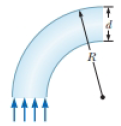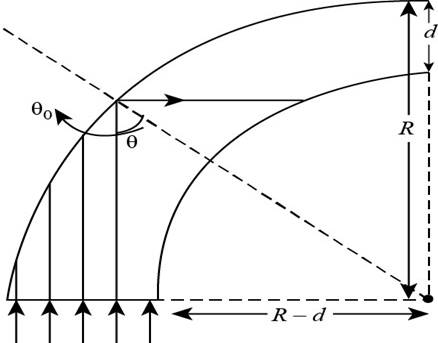
Concept explainers
An optical fiber has an index of refraction n and diameter d. It is surrounded by vacuum. Light is sent into the fiber along its axis as shown in Figure P34.31. (a) Find the smallest outside radius Rmin permitted for a bend in the fiber if no light is to escape. (b) What If? What result does part (a) predict as d approaches zero? Is this behavior reasonable? Explain. (c) As n increases? (d) As n approaches 1? (c) Evaluate Rmin assuming the fiber diameter is 100 μm and its index of refraction is 1.40.
Figure P34.31

(a)
Answer to Problem 35.49P
Explanation of Solution
Given info: The index of refraction is
The figure that represents the given conditions is shown below,

Figure (1)
From figure a ray originally moves along the inner edge will have the smallest angle of incidence when it strikes the outer edge of the fiber in the curve. Thus, if this ray is totally internally reflected, all of the others are also totally reflected.
The necessary condition for the ray to be total internal reflection is,
Here,
For very small value of
The above condition can be written as,
The expression of
Substitute 1 for the value of
The expression of
Here,
The expression of equation (1) becomes.
The minimum value of outside radius permitted for a bend in the fiber is
Conclusion:
Therefore, the smallest outside radius
(b)
Answer to Problem 35.49P
Explanation of Solution
The result from part (a) is,
Here,
The value of
The lesser value of
The thinner the optical fiber, the radius up to which the fiber is bent becomes smaller.
Conclusion:
Therefore, the
(c)
Answer to Problem 35.49P
Explanation of Solution
As
Here,
The above expression can be written as,
It is clear that as
Yes, as
Conclusion:
Therefore, the
(d)
Answer to Problem 35.49P
Explanation of Solution
As
Here,
The above expression can be written as,
It is clear that as
Yes, as
Conclusion:
Therefore, the value
(e)
Answer to Problem 35.49P
Explanation of Solution
Given info: The diameter of the fiber is
Explanation:
The formula to calculate the
Here,
Substitute
Conclusion:
Therefore, the value of
Want to see more full solutions like this?
Chapter 35 Solutions
EBK PHYSICS FOR SCIENTISTS AND ENGINEER
- Page 2 SECTION A Answer ALL questions in Section A [Expect to use one single-sided A4 page for each Section-A sub question.] Question A1 SPA6308 (2024) Consider Minkowski spacetime in Cartesian coordinates th = (t, x, y, z), such that ds² = dt² + dx² + dy² + dz². (a) Consider the vector with components V" = (1,-1,0,0). Determine V and V. V. (b) Consider now the coordinate system x' (u, v, y, z) such that u =t-x, v=t+x. [2 marks] Write down the line element, the metric, the Christoffel symbols and the Riemann curvature tensor in the new coordinates. [See the Appendix of this document.] [5 marks] (c) Determine V", that is, write the object in question A1.a in the coordinate system x'. Verify explicitly that V. V is invariant under the coordinate transformation. Question A2 [5 marks] Suppose that A, is a covector field, and consider the object Fv=AAμ. (a) Show explicitly that F is a tensor, that is, show that it transforms appropriately under a coordinate transformation. [5 marks] (b)…arrow_forwardHow does boiling point of water decreases as the altitude increases?arrow_forwardNo chatgpt pls will upvotearrow_forward
- 14 Z In figure, a closed surface with q=b= 0.4m/ C = 0.6m if the left edge of the closed surface at position X=a, if E is non-uniform and is given by € = (3 + 2x²) ŷ N/C, calculate the (3+2x²) net electric flux leaving the closed surface.arrow_forwardNo chatgpt pls will upvotearrow_forwardsuggest a reason ultrasound cleaning is better than cleaning by hand?arrow_forward
- Checkpoint 4 The figure shows four orientations of an electric di- pole in an external electric field. Rank the orienta- tions according to (a) the magnitude of the torque on the dipole and (b) the potential energy of the di- pole, greatest first. (1) (2) E (4)arrow_forwardWhat is integrated science. What is fractional distillation What is simple distillationarrow_forward19:39 · C Chegg 1 69% ✓ The compound beam is fixed at Ę and supported by rollers at A and B. There are pins at C and D. Take F=1700 lb. (Figure 1) Figure 800 lb ||-5- F 600 lb بتا D E C BO 10 ft 5 ft 4 ft-—— 6 ft — 5 ft- Solved Part A The compound beam is fixed at E and... Hình ảnh có thể có bản quyền. Tìm hiểu thêm Problem A-12 % Chia sẻ kip 800 lb Truy cập ) D Lưu of C 600 lb |-sa+ 10ft 5ft 4ft6ft D E 5 ft- Trying Cheaa Những kết quả này có hữu ích không? There are pins at C and D To F-1200 Egue!) Chegg Solved The compound b... Có Không ☑ ||| Chegg 10 וחarrow_forward
 Physics for Scientists and EngineersPhysicsISBN:9781337553278Author:Raymond A. Serway, John W. JewettPublisher:Cengage Learning
Physics for Scientists and EngineersPhysicsISBN:9781337553278Author:Raymond A. Serway, John W. JewettPublisher:Cengage Learning Physics for Scientists and Engineers with Modern ...PhysicsISBN:9781337553292Author:Raymond A. Serway, John W. JewettPublisher:Cengage Learning
Physics for Scientists and Engineers with Modern ...PhysicsISBN:9781337553292Author:Raymond A. Serway, John W. JewettPublisher:Cengage Learning Principles of Physics: A Calculus-Based TextPhysicsISBN:9781133104261Author:Raymond A. Serway, John W. JewettPublisher:Cengage Learning
Principles of Physics: A Calculus-Based TextPhysicsISBN:9781133104261Author:Raymond A. Serway, John W. JewettPublisher:Cengage Learning Physics for Scientists and Engineers: Foundations...PhysicsISBN:9781133939146Author:Katz, Debora M.Publisher:Cengage Learning
Physics for Scientists and Engineers: Foundations...PhysicsISBN:9781133939146Author:Katz, Debora M.Publisher:Cengage Learning College PhysicsPhysicsISBN:9781305952300Author:Raymond A. Serway, Chris VuillePublisher:Cengage Learning
College PhysicsPhysicsISBN:9781305952300Author:Raymond A. Serway, Chris VuillePublisher:Cengage Learning College PhysicsPhysicsISBN:9781285737027Author:Raymond A. Serway, Chris VuillePublisher:Cengage Learning
College PhysicsPhysicsISBN:9781285737027Author:Raymond A. Serway, Chris VuillePublisher:Cengage Learning





